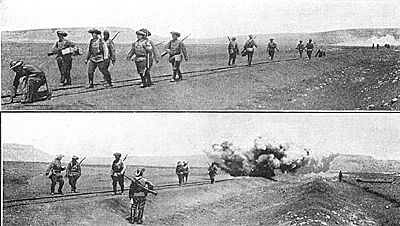
On the outbreak of war, the South African Prime Minister, General Louis Botha, himself an Afrikaner hero of the Boer War, not only offered the newly created South African Defence Force to protect South Africa itself, but also agreed to launch an invasion of German South-West.
Retreating Germans destroy a railway. Top: Placing the charge. Bottom: The charge explodes.
In theory, the South Africans could raise about 60,000 men, but in fact the first blow was dealt by the Royal Navy, which opened hostilities by bombarding and destroying the radio station and port facilities at Swakopmund.
This was followed on September 19th by an unopposed landing at Luderitzbucht by a South African force of 1,800 men under Sir Duncan MacKenzie, whose most recent campaigning had been against the Zulus in the 1906 Natal Rebellion. Another contingent of 2,500 men led by BrigadierGeneral Henry Lukin disembarked at Port Nolloth, the only port of Namaqualand, and advanced northwards to seize the drifts (fords) along the Orange River, which marked the border between South Africa and the German Colony.
Lukin's force consisted mainly of mounted infantry, including five battalions of the South African Mounted Rifles, two batteries of the Transvaal Horse Artillery, and an infantry regiment, the Witwatersrand Rifles. On September 25th, a patrol of 120 men under Captain E.J. Welsby, which had previously crossed the border, occupied Sandfontein, about 24 miles north of the Orange River, an unprepossessing collection of two or three shacks surrounding three wells and dominated by a 150 foot high kopje (hill).
Early on the 261h, Welsby was reinforced by LieutenantColonel Carter, with a squadron of the 1st South African Mounted Rifles, and two 13 pounders and a machine-gun section of the Transvaal Horse Artillery. Soon after, the South African force came under a heavy attack from a strong German force of about 2000 men, including three batteries with 12 guns, and led by von Heydebreck himself.
The Germans made excellent use of their guns, and, in what was primarily and artillery engagement, the South Africans found themselves outclassed, and, despite a gallant defence, suffered heavily. By the end of the day they had been forced to surrender, having suffered 60 casualties as against 67 inflicted on their opponents.
This initial German success was followed by the anticipated Afrikaner uprising in the Orange River Colony and the Transvaal. This was not completely suppressed until December, and it effectively occupied the toilk of the South African forces for most of this time. It was not until the end of the year that Botha was able to again consider operations against South West Africa.
More German Southwest Africa 1914-1915
Back to Colonial Conquest Issue 10 Table of Contents
Back to Colonial Conquest List of Issues
Back to MagWeb Master List of Magazines
© Copyright 1995 by Partizan Press.
This article appears in MagWeb (Magazine Web) on the Internet World Wide Web.
Other military history articles and gaming articles are available at http://www.magweb.com